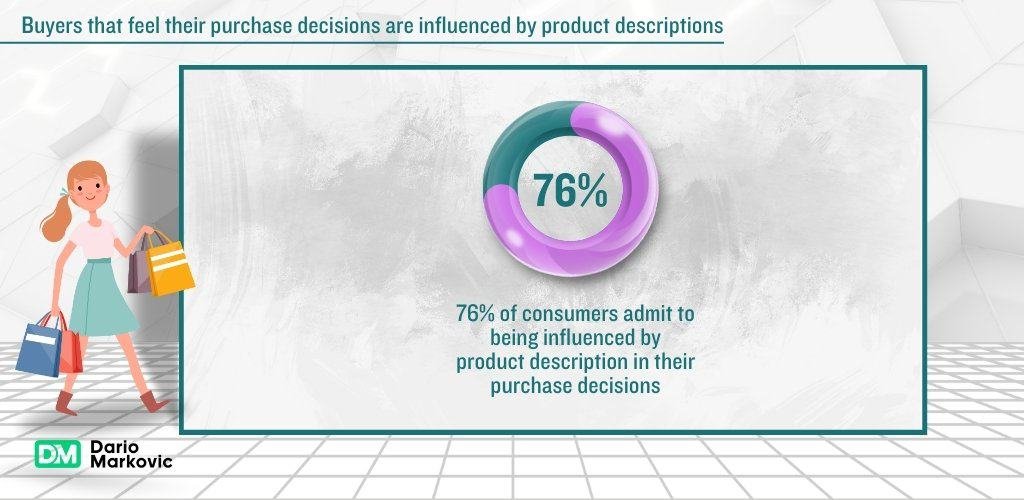Writing tech product descriptions for tech gadgets on Shopify is essential for attracting and converting potential customers. Writing tech product descriptions requires a blend of creativity, clarity, and strategic thinking.
In this blog, we’ll explore various aspects of crafting effective product descriptions to help you stand out in the competitive tech market.
3 Point Summary
Understand Your Audience: Consider your target audience’s needs, preferences, and pain points when crafting your product descriptions.
Highlight Key Features and Benefits: Clearly describe your tech gadgets’ unique features and benefits to show how they can solve specific problems for your customers.
Incorporate SEO Best Practices: Use relevant keywords naturally throughout your content to improve search engine visibility and attract more potential customers.
Understanding Your Audience
Writing tech product descriptions starts with understanding your target audience. Knowing who you are writing for allows you to tailor your language, tone, and content to resonate with them.
For tech gadgets, your audience might include tech enthusiasts, early adopters, and everyday consumers looking for practical solutions. Consider their needs, preferences, and pain points to create descriptions that speak directly to them.
Highlighting Key Features and Benefits
When writing tech product descriptions, it’s crucial to highlight the key features and benefits of your gadgets. Focus on what makes your product unique and how it can solve specific customer problems.
Use clear and concise language to describe the features and emphasize the benefits to show your product’s value. Potential buyers want to know how your gadget will improve their lives.
Using Persuasive Language
Persuasive language is a powerful tool when writing tech product descriptions. Use action-oriented words and phrases that encourage customers to take the next step, whether it’s making a purchase or learning more about the product.
Avoid jargon and technical terms that might confuse your audience. Instead, use simple and relatable language that makes your product accessible to everyone.
Incorporating SEO Best Practices
Incorporating SEO best practices is essential for writing tech product descriptions that rank well on search engines. Use relevant keywords, such as “writing tech product descriptions,” naturally throughout your content.
Include keywords in the title, headings, and body text to improve your search engine visibility. Use meta descriptions and alt text for images to enhance your SEO efforts.
Importance of Product Descriptions
85% of online shoppers say that product information is a key factor when deciding on which store to buy from.
87% of consumers consider product content the most important factor when buying a product online, as they can’t physically see the product.
60% of shoppers are more likely to buy from a site that offers detailed product descriptions.
Impact on Sales and Conversion Rates
- 50% of online purchases are influenced by product descriptions that highlight key features and benefits.
- 40% of consumers abandon their carts due to unclear or insufficient product information.
- 70% of consumers rely on product descriptions to make purchasing decisions.

SEO and Visibility
- Using relevant keywords in product descriptions can improve search engine visibility and attract more potential customers.
- Meta descriptions and alt text for images enhance SEO efforts and improve search engine rankings.
Customer Trust and Credibility
- Customer reviews and testimonials significantly impact purchasing decisions, with positive reviews building trust and credibility.
- Authentic reviews make potential buyers more confident in their decision to purchase.
User Experience
- Bullet lists in product descriptions make it easy for customers to quickly scan and understand the key points of a product.
- Clear and concise language helps avoid confusion and makes the product accessible to a wider audience.
These statistics highlight the importance of writing clear, detailed, and persuasive tech product descriptions. Focusing on these key aspects allows you to create compelling product descriptions that attract and convert potential customers on Shopify.
Examples of How Gadgets Improve Daily Life or Solve Specific Problems
Tech gadgets can significantly enhance daily activities and solve common issues:
Smart Home Devices: These can automate home tasks, improving convenience and security. For instance, a smart thermostat can learn your schedule and adjust temperatures automatically.
Wearable Fitness Trackers: These help users monitor their health by tracking steps, heart rate, and sleep patterns. This aids in achieving fitness goals and maintaining a healthy lifestyle.
Noise-Canceling Headphones: Ideal for remote workers or frequent travelers, these headphones block out ambient noise, creating a focused work environment or a peaceful travel experience.
Using Relatable Language to Connect with Potential Buyers
Connecting with customers through relatable language is crucial in crafting compelling product descriptions. Avoid jargon and technical terms that might confuse readers. Instead, use everyday language that resonates with their experiences:
- Replace “high-resolution display” with “crystal-clear screen for binge-watching your favorite shows.”
- Swap “ergonomic design” with “comfortable fit for all-day use.”
By adopting a customer-centric approach, you make the product’s benefits tangible and relevant. This strategy not only informs but also persuades potential buyers by showing them how the gadget fits seamlessly into their lives.
Using these techniques ensures your product descriptions are not just informative but also engaging, making it easier for customers to see the real value behind each feature.
Creating Engaging Bullet Lists
Bullet lists are an effective way to present information clearly and concisely. When writing tech product descriptions, bullet lists highlight key features, benefits, and specifications. Here’s an example:
- High-resolution display: Enjoy crystal-clear visuals with a 4K resolution screen.
- Long battery life: Stay connected all day with up to 12 hours of battery life.
- Fast charging: Get a full charge in 30 minutes with fast charging technology.
- Lightweight design: Carry your gadget anywhere with its sleek and portable design.
- Advanced security features: Protect your data with biometric authentication and encryption.
Bullet lists make it easy for customers to quickly scan and understand the key points of your product.
Techniques for Making Descriptions Relatable and Appealing
To make descriptions more relatable:
- Use Everyday Scenarios: Describe how the gadget can fit into common situations.
- Example: “Imagine starting your day with a fresh cup of coffee brewed effortlessly by our smart coffee maker.”
- Address Pain Points: Clearly state how your product solves specific problems.
- Example: “Tired of your phone running out of battery halfway through the day? Our long-lasting battery ensures you stay connected from morning to night.”
- Incorporate Customer Language: Use phrases and words that your target audience commonly uses.
- Example: If your audience frequently uses terms like “user-friendly” or “plug-and-play,” incorporate those into your descriptions.
An engaging product description not only informs but also captivates. By adopting a conversational tone, utilizing sensory language, and employing techniques to make descriptions relatable, you create an appealing narrative that resonates with potential buyers.
Showcasing Customer Reviews and Testimonials
Customer reviews and testimonials can significantly impact purchasing decisions. When writing tech product descriptions, include positive reviews and testimonials from satisfied customers.
Highlight specific features and benefits mentioned by customers to reinforce the value of your product. Authentic reviews build trust and credibility, making potential buyers more confident in their decision.
Crafting a Brief Value Story
A compelling value story highlights the unique advantages of your gadget within a few sentences. This section should:
- Address a common problem or need that your gadget solves.
- Mention specific features only if they directly relate to the benefits.
- Use relatable language and scenarios to make the content engaging.
Example:
Experience uninterrupted audio with our noise-canceling wireless earbuds, designed for music lovers who crave crystal-clear sound even in noisy environments.
Benefits of Storytelling in Tech Product Descriptions
Increased Relatability: Stories help customers connect with the product on a personal level.
Enhanced Engagement: Narratives capture attention and keep readers interested.
Improved Conversion Rates: Emotional connections through storytelling can lead to higher sales.
Relatable Scenarios in Writing Tech Product Descriptions
Here are some effective ways to incorporate relatable scenarios into your tech product descriptions:
- Daily Use Cases: Describe everyday situations where the gadget proves beneficial. For example, a smartwatch can be portrayed as an essential tool for a busy professional managing their schedule and health metrics seamlessly.
- Problem-Solution Framework: Highlight specific problems that the gadget solves. A noise-canceling headphone description might include a story about someone finding peace in a noisy office or during travel.
- User Journey: Narrate the experience from unboxing to daily usage. This helps customers envision owning and using the gadget, enhancing its appeal.
Techniques for Incorporating Narratives into Product Descriptions
Here are some techniques you can use to effectively incorporate narratives into your tech product descriptions:
- Character Introduction: Introduce a character similar to your target audience. This person faces common challenges that your gadget addresses.
- Setting the Scene: Create a vivid setting where the character uses the gadget. Use sensory language to paint a detailed picture.
- Conflict and Resolution: Present a conflict or problem that disrupts the character’s routine. Show how the gadget provides a solution, restoring harmony.
- Emotional Connection: Highlight emotional benefits such as convenience, security, or happiness derived from using the gadget.
- Call to Action through Storytelling: End with an invitation for potential buyers to experience these benefits by purchasing the product.
Example:
Jane, a busy marketing executive, often missed important calls while commuting. Frustrated with her old headset’s poor battery life and sound quality, she decided to try our new wireless earbuds. The first day she used them, she noticed how crystal-clear her calls were and how effortlessly they connected to her phone. Now, Jane never misses a call, even on her busiest days.
By embracing storytelling techniques in writing tech product descriptions, you can enhance relatability and drive engagement and conversion rates by connecting emotionally with the customer.
My Personal Experience
As a Shopify seller focusing on digital products for moms, particularly young black mothers, I’ve learned the importance of writing tech product descriptions that resonate with my audience. By understanding their needs and preferences, I’ve created descriptions highlighting the practical benefits of my products. For example, I emphasize features like ease of use, comfort, and health-tracking capabilities when selling wearable fitness tech. This approach has helped me connect with my audience and drive sales.
In conclusion, writing tech product descriptions requires a strategic approach that combines creativity, clarity, and SEO best practices. You can create compelling product descriptions that attract and convert potential customers by understanding your audience, highlighting key features and benefits, using persuasive language, incorporating statistics, creating engaging bullet lists, and showcasing customer reviews.
FAQ
Product descriptions are crucial because they provide potential customers with the information they need to make informed purchasing decisions. They highlight the key features and benefits of the product, build trust, and improve search engine visibility.
To make your tech product descriptions more engaging, use clear and concise language, focus on the benefits, and include bullet points for easy readability. Incorporate persuasive language and avoid jargon that might confuse your audience.
- Understand your audience: Tailor your descriptions to resonate with your target audience.
- Highlight key features and benefits: Clearly describe what makes your product unique.
- Use SEO best practices: Include relevant keywords naturally throughout your content.
- Incorporate customer reviews: Add testimonials to build trust and credibility.
To optimize your product descriptions for SEO, use relevant keywords in the title, headings, and body text. Include meta descriptions and alt text for images. Ensure your content is clear, concise, and informative to improve search engine rankings.
Customer reviews and testimonials can significantly impact purchasing decisions. Positive reviews build trust and credibility, making potential buyers more confident in their decision to purchase.
Your product descriptions should be detailed enough to provide all necessary information but concise enough to keep the reader’s attention. Focus on the key features, benefits, and any unique selling points of your product.
Yes, using bullet points is highly recommended. Bullet points make it easy for customers to quickly scan and understand the key points of your product. They help break down complex information into digestible chunks.
To avoid using jargon, focus on explaining the features and benefits in simple, relatable language. Think about how you would describe the product to someone who is not familiar with technical terms.
To make your product descriptions stand out, focus on the unique selling points of your product, use engaging and persuasive language, and incorporate high-quality images and videos. Highlight customer reviews and use bullet points for easy readability.



